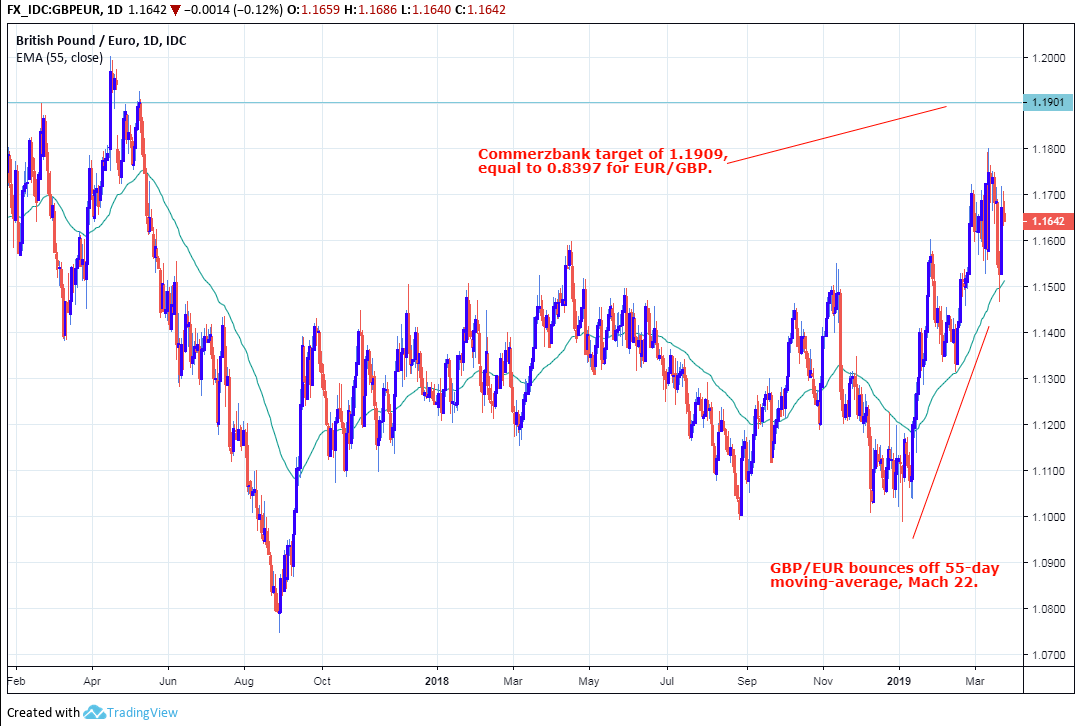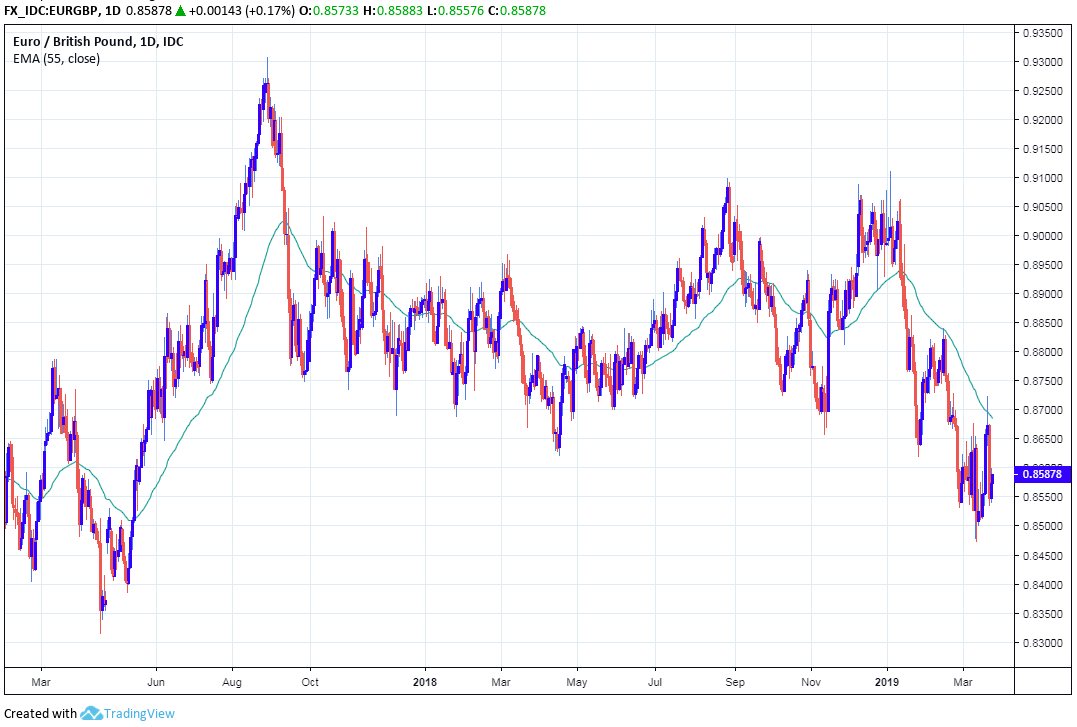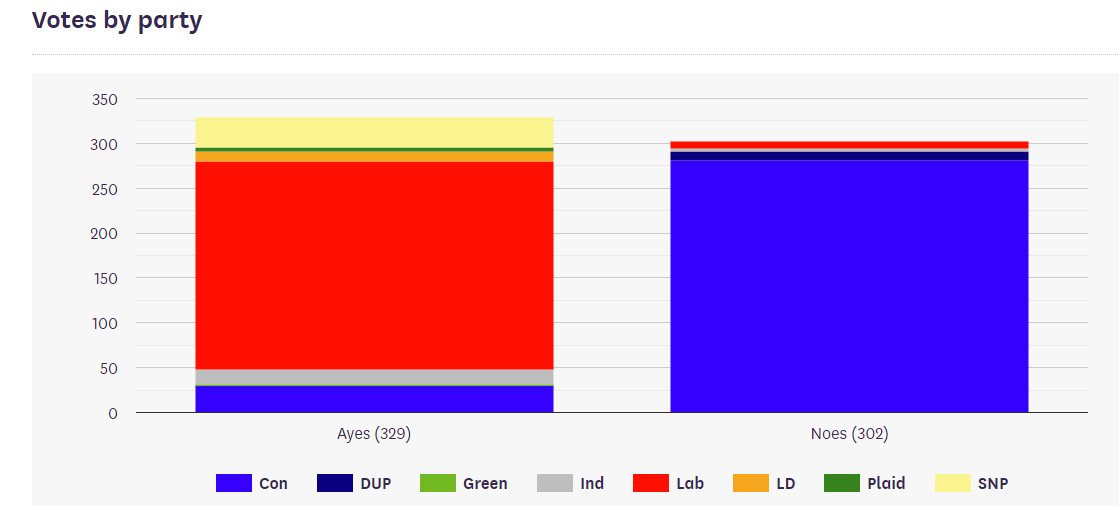The Pound-to-Euro Rate is Eyeing Key 1.19 Level says Commerzbank Technical Analyst
- Written by: James Skinner

Commerzbank HQ dominates the Frakfurt skyline. Image © Andre Douque, reproduced under CC licensing conditions
- GBP retains upside bias so long as 1.15 holds says Commerzbank.
- Rejection of 55-day moving average augurs challenge of 200-week.
- Technical picture brightens as Parliament moves against Brexit.
Sterling remains the best performing currency in the G10 universe this year but the Pound-to-Euro rate can still rise further in the coming days and weeks, according to technical analysts at Commerzbank, who say the market could soon challenge the 200-week moving-average close to the 1.19 level.
Commerzbank's call comes at a time when Pound Sterling has been lifted through the league table by commitments from Prime Minister Theresa May and MPs in Parliament to avoiding a so-called no deal Brexit.
It also comes amid rising market hopes of a lengthy delay to the Brexit process that could be followed by either a future relationship that includes a permanent customs union or another referendum on the European Union question.
Meanwhile, the economy has continued to perform strongly even in the face of a political crisis in Westminster, which is in full flow given how Conservative Party MPs including members of the cabinet have openly rebelled against the government in order to force a form of "soft Brexit".
All of those things have helped to keep market hopes of a 2019 Bank of England interest rate alive, albeit on life support, and to put the wind back into the sails of Pound Sterling. The Pound-to-Euro rate is already up 5% for 2019 but Commerzbank says it could rise an additional 1% over the coming weeks.

Above: Pound-to-Euro rate shown at daily intervals. Annotated with Commerzbank target.
"EUR/GBP has seen complete rejection from the 55 day moving-average (MA) at .8700. This leaves the attention on the .8471 recent low and there is a risk of a slide to the 200 week ma at .8397," says says Karen Jones, head of technical analysis at Commerzbank. "Initial resistance lies at .8722 (22nd February high) and .8842 (200 day ma). While capped here, a negative bias remains."
Jones refers to the inverse of the Pound-to-Euro rate. In those terms she says Sterling should remain biased toward continued gains so long as the market can hold above the 1.15 level. The market already bounced offf that level on March 22, effectively rejecting a move below.
Her target of 0.8397 for EUR/GBP translates into a Pound-to-Euro rate of 1.1909. This is also the 200-week moving average of closing prices. Such levels are formidable barriers that require significant momentum to be overcome.

Above: EUR/GBP rate shown at daily intervals. Shows rejection of 55-day moving-average, March 22.
MPs decided by a majority of 329:302 to reserve Wednesday's parliamentary business for voting on amendments to a non-binding motion, which is designed to enable them to show the government exactly what their preferred relationship with the EU will look like.
That amendment had been put forward by Conservative Party MPs Oliver Letwin and Dominic Grieve, as well as opposition MP Hilary Benn. 30 of the government's MPs are said to have rebelled in order to support it and three cabinet members resigned from office to that end.
Monday's win for opponents of the government could now give way to House of Commons votes on a permanent customs union with the EU, European Economic Area membership, another referendum and a range of other scenarios including the revocation of Article 50.
"The market is likely to – rightly – wonder whether the fact that the House of Commons is now able to vote on different Brexit options on Wednesday is going to change the stalemate in any way," says Ulrich Leuchtmann, head of FX strategy at Commerzbank. "The alternatives to Theresa May’s deal, such as a second referendum or snap elections, are likely to seem just as unattractive to the majority of MPs – certainly on the Tory side."

Above: Parliamentary result for amendment (a) Letwin.
Prime Minister Theresa May told the House of Commons Monday that she has not yet set a date for the third vote on her EU Withdrawal Agreement because she cannot be sure that it has enough support among MPs to clear the House.
She also told parliamentarians that a so-called no deal Brexit will not happen unless there is a majority in the House of Commons for it. However, she then claimed that she will not allow the government to become bound by "indicative votes" on non-binding motions.
This sets the stage for what could be a days-long period of horse-trading between Conservative Party MPs on the back benches and the Prime Minister as she attempts to coerce the handful of Brexit-supporting lawmakers in her party into backing her proposed withdrawal Treaty.
"There is a considerable risk that the House of Commons will be unable to agree on any option tomorrow," Leuchtmann says. "The condition for the UK not leaving the EU in a disorderly manner on 12th April is that Parliament comes up with a plan on how to proceed."
A so-called no deal Brexit remains an option on the table despite it having been rejected by MPs in a parliamentary ballot earlier in March and the market's focus has now turned toward April 12.
That date will see government choose between a further extension of the Article 50 negotiating window and leaving the EU without a withdrawal agreement if the House of Commons has not backed the EU Withdrawal Agreement by then.
Time to move your money? Get 3-5% more currency than your bank would offer by using the services of foreign exchange specialists at RationalFX. A specialist broker can deliver you an exchange rate closer to the real market rate, thereby saving you substantial quantities of currency. Find out more here.
* Advertisement




